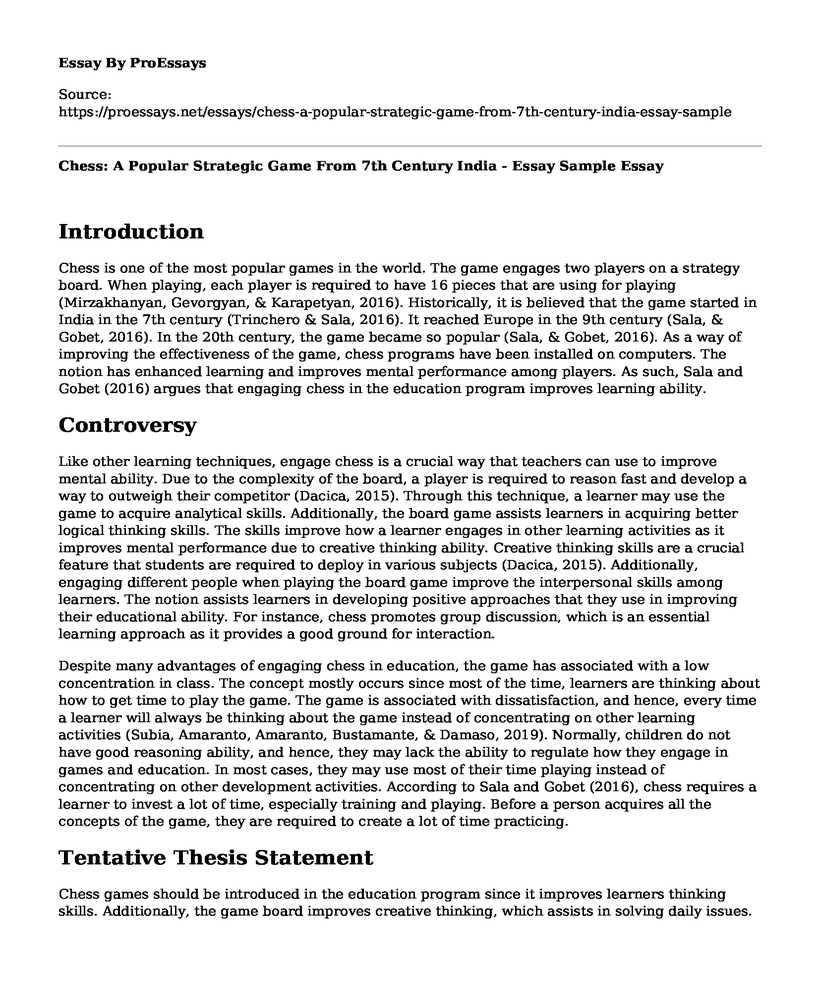Introduction
Chess is one of the most popular games in the world. The game engages two players on a strategy board. When playing, each player is required to have 16 pieces that are using for playing (Mirzakhanyan, Gevorgyan, & Karapetyan, 2016). Historically, it is believed that the game started in India in the 7th century (Trinchero & Sala, 2016). It reached Europe in the 9th century (Sala, & Gobet, 2016). In the 20th century, the game became so popular (Sala, & Gobet, 2016). As a way of improving the effectiveness of the game, chess programs have been installed on computers. The notion has enhanced learning and improves mental performance among players. As such, Sala and Gobet (2016) argues that engaging chess in the education program improves learning ability.
Controversy
Like other learning techniques, engage chess is a crucial way that teachers can use to improve mental ability. Due to the complexity of the board, a player is required to reason fast and develop a way to outweigh their competitor (Dacica, 2015). Through this technique, a learner may use the game to acquire analytical skills. Additionally, the board game assists learners in acquiring better logical thinking skills. The skills improve how a learner engages in other learning activities as it improves mental performance due to creative thinking ability. Creative thinking skills are a crucial feature that students are required to deploy in various subjects (Dacica, 2015). Additionally, engaging different people when playing the board game improve the interpersonal skills among learners. The notion assists learners in developing positive approaches that they use in improving their educational ability. For instance, chess promotes group discussion, which is an essential learning approach as it provides a good ground for interaction.
Despite many advantages of engaging chess in education, the game has associated with a low concentration in class. The concept mostly occurs since most of the time, learners are thinking about how to get time to play the game. The game is associated with dissatisfaction, and hence, every time a learner will always be thinking about the game instead of concentrating on other learning activities (Subia, Amaranto, Amaranto, Bustamante, & Damaso, 2019). Normally, children do not have good reasoning ability, and hence, they may lack the ability to regulate how they engage in games and education. In most cases, they may use most of their time playing instead of concentrating on other development activities. According to Sala and Gobet (2016), chess requires a learner to invest a lot of time, especially training and playing. Before a person acquires all the concepts of the game, they are required to create a lot of time practicing.
Tentative Thesis Statement
Chess games should be introduced in the education program since it improves learners thinking skills. Additionally, the game board improves creative thinking, which assists in solving daily issues.
Section 4
Conducting research on the role of chess in education will provide an opportunity to understand the importance of games in learning programs. Despite learning being a crucial aspect of life, the process needs to be supplemented with other programs to improve its effectiveness. Currently, there are a lot of studies that have been conducted regarding the topic of study. Therefore, the topic has a lot of data that can be used to conduct the research. Most of these articles focus on how chess improves learning ability among children. I would advise future learners to engage in games in their learning programs. Chess is one of the best games they can include in the learning program since it improves learning their learning and thinking ability. Additionally, the game tries to refresh their minds, thus improving their concentration rate.
References
Dacica, L. (2015). The formative role of physical education and sports. Procedia-Social and Behavioral Sciences, 180, 1242-1247. Retrieved from https://www.sciencedirect.com/science/article/pii/S187704281501602X/pdf?md5=6f35cb71e164b5b416f679049b4e82e5&pid=1-s2.0-S187704281501602X-main.pdf&_valck=1.
Mirzakhanyan, R., Gevorgyan, S., & Karapetyan, V. (2016). Research as a Deliberate Chess Activity Software Testing Platform for Professional Dynamic Development of the Education Sector. Management, 4(4), 161-166. Retrieved from www.davidpublisher.org/Public/uploads/Contribute/5715e8ea0e14f.pdf.
Sala, G., & Gobet, F. (2016). Do the benefits of chess instruction transfer to academic and cognitive skills? A meta-analysis. Educational Research Review, 18, 46-57. Retrieved from https://www.sciencedirect.com/science/article/pii/S1747938X16300112.
Subia, G. S., Amaranto, J. L., Amaranto, J. C., Bustamante, J. Y., & Damaso, I. C. (2019). Chess and Mathematics Performance of College Players: An Exploratory Analysis. Open Access Library Journal, 6(2), 1-7. Retrieved from https://www.scirp.org/journal/paperinformation.aspx?paperid=90343.
Trinchero, R., & Sala, G. (2016). Chess training and mathematical problem-solving: the role of teaching heuristics in transfer of learning. Eurasia Journal of Mathematics, Science & Technology Education, 12(3), 655-668. Retrieved from http://www.ejmste.com/Chess-Training-and-Mathematical-Problem-Solving-The-Role-of-Teaching-Heuristics-in-Transfer-of-Learning,60955,0,2.html.
Cite this page
Chess: A Popular Strategic Game From 7th Century India - Essay Sample. (2023, Mar 03). Retrieved from https://proessays.net/essays/chess-a-popular-strategic-game-from-7th-century-india-essay-sample
If you are the original author of this essay and no longer wish to have it published on the ProEssays website, please click below to request its removal:
- Stealth Assessment in Games - Essay Sample
- Essay Sample on Division I Student-Athletes
- Essay Sample on Gaming Industry
- Steroid Use in the MLB: 50 Year History - Research Paper
- Essay Sample on Sporting Risk Management Decisions
- Dari's Passion Drives Success: The Story of JCF Sport and Fitness Co - Essay Sample
- Essay Example on Montana Grizzlies Football Team's Social Media Presence







